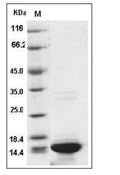- Remove All
 Your shopping cart is currently empty
Your shopping cart is currently empty
HIST3H2A Protein, Human, Recombinant
Histones are a complex family of highly conserved basic proteins responsible for packaging chromosomal DNA into nucleosomes. There are subtype diversities: H1, H2A, H2B, and H3 or H4. It has become more and more evident that histone modifications are key players in the regulation of chromatin states and dynamics as well as in gene expression. Therefore, histone modifications and the enzymatic machinery that set them are crucial regulators that can control cellular proliferation, differentiation, plasticity, and malignancy processes. However, extracellular histones are a double-edged sword because they also damage host tissue and may cause death. Histones bound to platelets, induced calcium influx, and recruited plasma adhesion proteins such as fibrinogen to induce platelet aggregation. Histone cluster 3, H2a also known as histone H2A (HIST3H2A) is a member of histones. Covalent modification of histones is important in regulating chromatin dynamics and transcription. One example of such modification is ubiquitination, which mainly occurs on histones H2A and H2B. E3 ubiquitin ligase complex is specific for histone H2A (HIST3H2A). Reducing the expression of Ring2 results in a dramatic decrease in the level of ubiquitinated H2A in HeLa cells. DNA damage induces monoubiquitylation of histone H2A (HIST3H2A) in the vicinity of DNA lesions.

HIST3H2A Protein, Human, Recombinant
| Pack Size | Price | Availability | Quantity |
|---|---|---|---|
| 100 μg | $488 | In Stock | |
| 200 μg | $832 | 7-10 days | |
| 500 μg | $1,680 | 7-10 days |
Product Information
| Biological Activity | Activity testing is in progress. It is theoretically active, but we cannot guarantee it. If you require protein activity, we recommend choosing the eukaryotic expression version first. |
| Description | Histones are a complex family of highly conserved basic proteins responsible for packaging chromosomal DNA into nucleosomes. There are subtype diversities: H1, H2A, H2B, and H3 or H4. It has become more and more evident that histone modifications are key players in the regulation of chromatin states and dynamics as well as in gene expression. Therefore, histone modifications and the enzymatic machinery that set them are crucial regulators that can control cellular proliferation, differentiation, plasticity, and malignancy processes. However, extracellular histones are a double-edged sword because they also damage host tissue and may cause death. Histones bound to platelets, induced calcium influx, and recruited plasma adhesion proteins such as fibrinogen to induce platelet aggregation. Histone cluster 3, H2a also known as histone H2A (HIST3H2A) is a member of histones. Covalent modification of histones is important in regulating chromatin dynamics and transcription. One example of such modification is ubiquitination, which mainly occurs on histones H2A and H2B. E3 ubiquitin ligase complex is specific for histone H2A (HIST3H2A). Reducing the expression of Ring2 results in a dramatic decrease in the level of ubiquitinated H2A in HeLa cells. DNA damage induces monoubiquitylation of histone H2A (HIST3H2A) in the vicinity of DNA lesions. |
| Species | Human |
| Expression System | E. coli |
| Tag | Tag Free |
| Accession Number | Q7L7L0 |
| Synonyms | MGC3165,histone cluster 3, H2a |
| Construction | A DNA sequence encoding the human HIST3H2A (NP_254280.1) (Met 1-Lys 130) was expressed and purified. Predicted N terminal: Met 1 |
| Protein Purity | > 90 % as determined by SDS-PAGE  |
| Molecular Weight | 14.2 kDa (predicted); 14.2 kDa (reducing conditions) |
| Endotoxin | Please contact us for more information. |
| Formulation | Lyophilized from a solution filtered through a 0.22 μm filter, containing 20 mM β-Mercaptoethanol, pH 6. 9. Typically, a mixture containing 5% to 8% trehalose, mannitol, and 0.01% Tween 80 is incorporated as a protective agent before lyophilization. |
| Reconstitution | A Certificate of Analysis (CoA) containing reconstitution instructions is included with the products. Please refer to the CoA for detailed information. |
| Stability & Storage | It is recommended to store recombinant proteins at -20°C to -80°C for future use. Lyophilized powders can be stably stored for over 12 months, while liquid products can be stored for 6-12 months at -80°C. For reconstituted protein solutions, the solution can be stored at -20°C to -80°C for at least 3 months. Please avoid multiple freeze-thaw cycles and store products in aliquots. |
| Shipping | In general, Lyophilized powders are shipping with blue ice. |
| Research Background | Histones are a complex family of highly conserved basic proteins responsible for packaging chromosomal DNA into nucleosomes. There are subtype diversities: H1, H2A, H2B, and H3 or H4. It has become more and more evident that histone modifications are key players in the regulation of chromatin states and dynamics as well as in gene expression. Therefore, histone modifications and the enzymatic machinery that set them are crucial regulators that can control cellular proliferation, differentiation, plasticity, and malignancy processes. However, extracellular histones are a double-edged sword because they also damage host tissue and may cause death. Histones bound to platelets, induced calcium influx, and recruited plasma adhesion proteins such as fibrinogen to induce platelet aggregation. Histone cluster 3, H2a also known as histone H2A (HIST3H2A) is a member of histones. Covalent modification of histones is important in regulating chromatin dynamics and transcription. One example of such modification is ubiquitination, which mainly occurs on histones H2A and H2B. E3 ubiquitin ligase complex is specific for histone H2A (HIST3H2A). Reducing the expression of Ring2 results in a dramatic decrease in the level of ubiquitinated H2A in HeLa cells. DNA damage induces monoubiquitylation of histone H2A (HIST3H2A) in the vicinity of DNA lesions. |
Dose Conversion
Calculator
Tech Support

Copyright © 2015-2025 TargetMol Chemicals Inc. All Rights Reserved.


